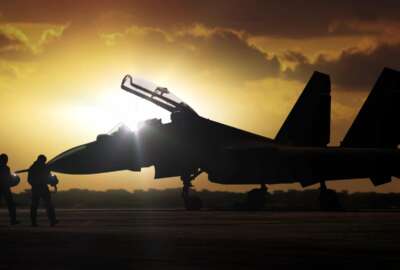Best listening experience is on Chrome, Firefox or Safari. Subscribe to Federal Drive’s daily audio interviews on Apple Podcasts or PodcastOne.
Its footsteps are big and loud, but the Air Force’s “Godzilla” class isn’t here to stomp on Tokyo.
Last week, the Air University’s Officer Training School in Maxwell Air Force Base in Alabama graduated 800 new officer airmen, the largest class since 1967.
Dubbed the Godzilla class, the Air Force trained nearly three times the usual amount of officer candidates between July and September in order to meet its quota by the end of the fiscal year on Oct. 1.
“Officer Training School usually separates its class start dates between classes by approximately eight days,” said Col. Peter Bailey, Officer Training School commandant. “For this class we started two classes on the same date. We also made up for a shortfall from the Air Force Academy and ROTC. We were able to make up for what ROTC and the Academy could not produce and add those students into the combined class. We needed to graduate that class before the end of the fiscal year.”
The school acts as a shock absorber for Air Force officer accessioning. It trains officers in 40 days rather than the four years it takes at ROTC or the academy. This year happened to be a perfect storm.
The extra students made for some cramped quarters.
“Crowded is the only word I can use to describe it,” Capt. Ryan Hager, an instructor at the school said. “Just looking around there’s constantly people. There were constantly people moving around you. You always had to be mindful where you’re walking or where you are talking because we are setting the example around here and there were constantly students around.”
Godzilla class graduate 2nd Lt. DeJaye Herrera said she embraced the challenge and learned more.
“All the students brought so much to the table,” she said. “The discussions were so much more in-depth with a larger, more diverse class, and we were able to share our perspectives. I definitely feel like the size of the class did not have a negative impact on my training at all.”
Bailey said as commandant he is always balancing quality and quantity. Despite the crowding, he guaranteed that the graduating airmen received the same quality of instruction as normal or smaller classes.
“My staff is prepared, they’re professional and they take their job very seriously,” he said.
Planning things like meal times and lectures required more forethought.
Bailey said sometimes the school needed to turn one lecture into two purely because a building couldn’t hold the number of students taking a class at one time.
The most important aspect was communication and coordination. Luckily, student to teacher ratio did not suffer during the Godzilla class.
If you’re wondering how the class got its name, there’s no one person responsible, but the moniker is a rallying cry.
“The staff came up with the idea,” Bailey said. “The students ran with it and everybody embraced it. It’s something that bonds people together and it’s funny — just a simple name of Godzilla creates a common theme or bond. In my mind it actually increased the motivation of the staff by taking on this huge challenge, as well as the students.”
Copyright
© 2024 Federal News Network. All rights reserved. This website is not intended for users located within the European Economic Area.
